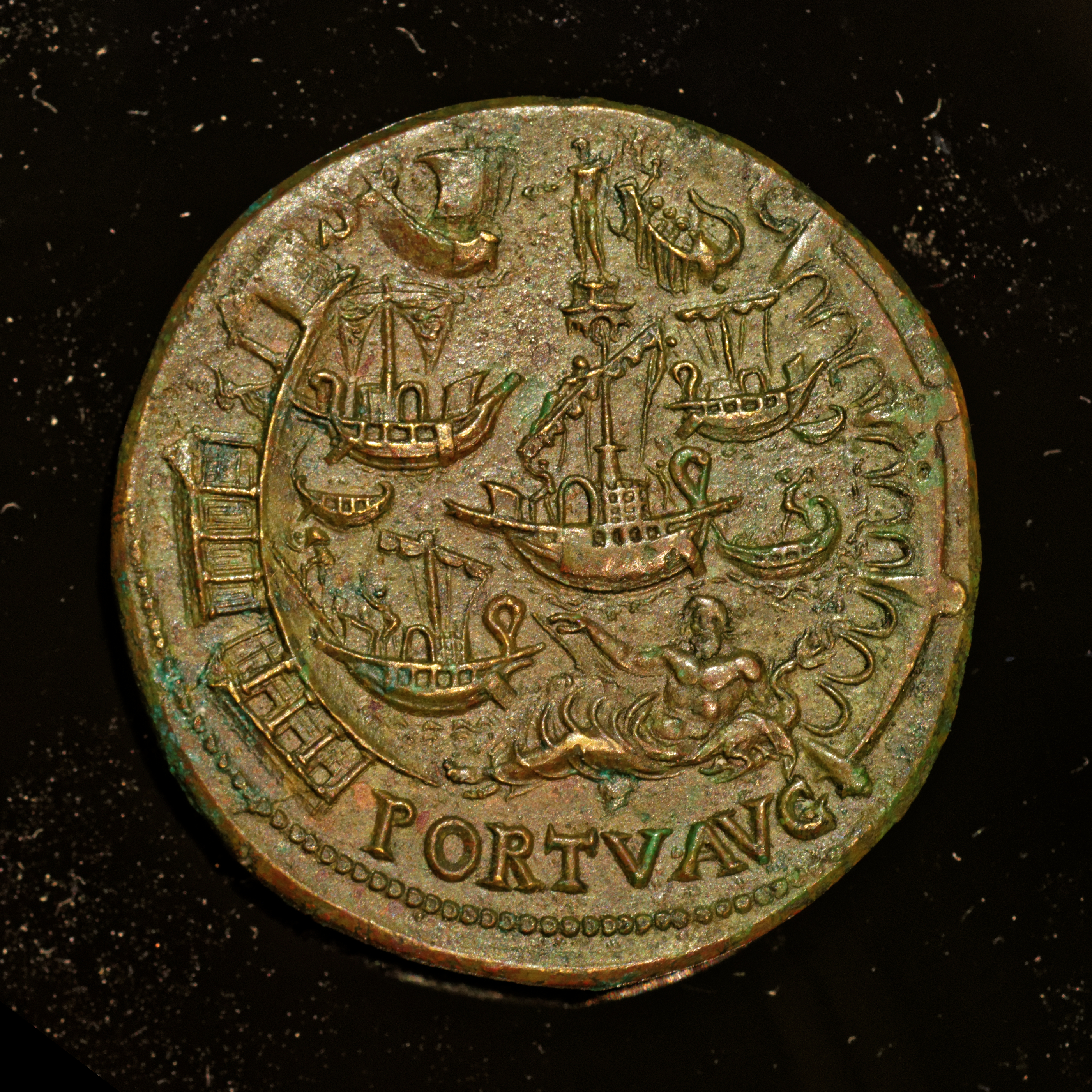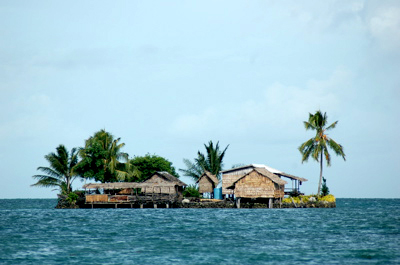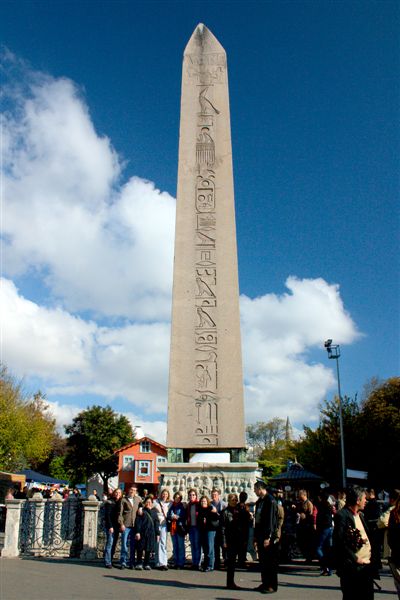|
Portus
Portus was a large artificial harbour of Ancient Rome located at the mouth of the Tiber on the Tyrrhenian Sea. It was established by Claudius and enlarged by Trajan to supplement the nearby port of Ostia. The archaeological remains of Portus are near the modern-day village of Porto within the ''comune'' of Fiumicino, Lazio, just southwest of Rome. Ancient Portus Claudian phase Ancient Rome's original port was Ostia located at the mouth of the Tiber on the Tyrrhenian Sea. The Tiber splits into two streams at its mouth, roughly 1 mile before reaching the Tyrrhenian, with Ostia situated on the larger southern stream. Emperor Claudius constructed the first harbour on the Portus site, north of Ostia, enclosing an area of 250 hectares (617 acres), with two long curving moles projecting into the sea, and an artificial island, bearing a lighthouse, in the centre of the space between them. The foundation of this lighthouse was provided by filling one of the massive obelisk ships ... [...More Info...] [...Related Items...] OR: [Wikipedia] [Google] [Baidu] |
Ostia Antica (archaeological Site)
Ostia Antica () is an ancient Roman city and the port of History of Rome, Rome located at the mouth of the Tiber. It is near modern Ostia (Rome), Ostia, southwest of Rome. Due to siltation, silting and the invasion of sand, the site now lies from the sea. The name ''Ostia'' (the plural of ''ostium'') derives from Latin ''os'' 'mouth'. Ostia is now a large Classical archaeology, archaeological site noted for the excellent preservation of its ancient buildings, magnificent frescoes and impressive mosaics. The city's decline after antiquity led to harbor deterioration, marshy conditions, and reduced population. Sand dunes covering the site aided its preservation. Its remains provide insights into a city of commercial importance. As in Pompeii, Ostia's ruins provide details about Roman urbanism that are not accessible within the city of Rome itself. History Origins Ostia may have been Rome's first ''colonia (Roman), colonia''. According to legend, Ancus Marcius, the fourth kings ... [...More Info...] [...Related Items...] OR: [Wikipedia] [Google] [Baidu] |
Fiumicino
Fiumicino () is a town and comune in the Metropolitan City of Rome, Lazio, central Italy, with a population of 80,500 (2019). It is known for being the site of Leonardo da Vinci–Fiumicino Airport, the busiest airport in Italy and the ninth-busiest in Europe, which serves Rome and much of central Italy. Etymology The name literally means ''little river''. The town of "Fiumicino" should not be confused with like-named Fiumicino, a small river near Rimini better known as the Rubicon river. Recent history The destroyer "Velos", in May 1973, (with a crew of 270 men in total) commanded by one of the pioneers of the movement, Admiral Nikos Pappas at the time, left the formation of vessels participating in a NATO exercise off the coast of Sardinia and rushed at the port of the city where seven officers (including the captain) and twenty-five petty officers requested political asylum from the Italian authorities, which, after many days of suffering, was granted. This went down i ... [...More Info...] [...Related Items...] OR: [Wikipedia] [Google] [Baidu] |
Port
A port is a maritime facility comprising one or more wharves or loading areas, where ships load and discharge cargo and passengers. Although usually situated on a sea coast or estuary, ports can also be found far inland, such as Hamburg, Manchester and Duluth; these access the sea via rivers or canals. Because of their roles as ports of entry for immigrants as well as soldiers in wartime, many port cities have experienced dramatic multi-ethnic and multicultural changes throughout their histories. Ports are extremely important to the global economy; 70% of global merchandise trade by value passes through a port. For this reason, ports are also often densely populated settlements that provide the labor for processing and handling goods and related services for the ports. Today by far the greatest growth in port development is in Asia, the continent with some of the world's largest and busiest ports, such as Singapore and the Chinese ports of Shanghai and Ningbo-Zhoushan. As ... [...More Info...] [...Related Items...] OR: [Wikipedia] [Google] [Baidu] |
Tiber
The Tiber ( ; ; ) is the List of rivers of Italy, third-longest river in Italy and the longest in Central Italy, rising in the Apennine Mountains in Emilia-Romagna and flowing through Tuscany, Umbria, and Lazio, where it is joined by the River Aniene, to the Tyrrhenian Sea, between Ostia (Rome), Ostia and Fiumicino. It Drainage basin, drains a basin estimated at . The river has achieved lasting fame as the main watercourse of the city of Rome, which was founded on its eastern banks. The river rises at Mount Fumaiolo in Central Italy and flows in a generally southerly direction past Perugia and Rome to meet the sea at Ostia (town), Ostia. The Tiber has advanced significantly at its mouth, by about , since Roman times, leaving the ancient port of Ostia Antica (archaeological site), Ostia Antica inland."Tiber River". ''Encyclopædia Britannica''. 2006 However, it does not form a proportional river delta, delta, owing to a strong north-flowing sea current close to the shore, d ... [...More Info...] [...Related Items...] OR: [Wikipedia] [Google] [Baidu] |
Obelisk Ships
Ships were used during the Eighteenth Dynasty of ancient Egypt to transport obelisks from the quarry to their destination. Fifteen centuries later, the Romans used ships to transport obelisks across the Mediterranean to Rome. Today, eight ancient Egyptian obelisks stand in Rome, though not in their original places. The first of the obelisks, the 263-ton Flaminian obelisk, was transported from Heliopolis – modern-day Cairo – in 10 BCE. while the last, the 500-ton Lateran obelisk, was transported from Karnak. Ancient Egypt The earliest obelisk ships were built in Ancient Egypt to transport obelisks via the Nile from the quarries to their destination. During the reign of Thutmose I, Ineni was granted superintendence of the king's building projects, which included the erection of two obelisks. A surviving text fragment documents that the obelisk ship had a length of ~ and a width of ~. A relief depicting Hatshepsut's barge loaded with two obelisks on its way to the grea ... [...More Info...] [...Related Items...] OR: [Wikipedia] [Google] [Baidu] |
Claudius
Tiberius Claudius Caesar Augustus Germanicus ( ; ; 1 August 10 BC – 13 October AD 54), or Claudius, was a Roman emperor, ruling from AD 41 to 54. A member of the Julio-Claudian dynasty, Claudius was born to Nero Claudius Drusus, Drusus and Antonia Minor at Lugdunum in Roman Gaul, where his father was stationed as a military legate. He was the first Roman emperor to be born outside Roman Italy, Italy. As he had a limp and slight deafness due to an illness he suffered when young, he was ostracized by his family and was excluded from public office until his consulship (which was shared with his nephew, Caligula, in 37). Claudius's infirmity probably saved him from the fate of many other nobles during the purges throughout the reigns of Tiberius and Caligula, as potential enemies did not see him as a serious threat. His survival led to him being declared emperor by the Praetorian Guard after Caligula's assassination, at which point he was the last adult male of his family. Despite ... [...More Info...] [...Related Items...] OR: [Wikipedia] [Google] [Baidu] |
Artificial Island
An artificial island or man-made island is an island that has been Construction, constructed by humans rather than formed through natural processes. Other definitions may suggest that artificial islands are lands with the characteristics of human intervention in their formation process, while others argue that artificial islands are created by expanding existing islets, constructing on existing reefs, or amalgamating several islets together. Although constructing artificial islands is not a modern phenomenon, there is no definite legal definition of it. Artificial islands may vary in size from small islets reclaimed solely to support a single pillar of a building or structure to those that support entire communities and cities. Archaeology, Archaeologists argue that such islands were created as far back as the Neolithic, Neolithic era. Early artificial islands included floating island, floating structures in still waters or wooden or megalithic structures erected in Ocean bank, s ... [...More Info...] [...Related Items...] OR: [Wikipedia] [Google] [Baidu] |
Lighthouse
A lighthouse is a tower, building, or other type of physical structure designed to emit light from a system of lamps and lens (optics), lenses and to serve as a beacon for navigational aid for maritime pilots at sea or on inland waterways. Lighthouses mark dangerous coastlines, hazardous shoals, reefs, rocks, and safe entries to harbors; they also assist in aerial navigation. Once widely used, the number of operational lighthouses has declined due to the expense of maintenance and the advent of much cheaper, more sophisticated, and more effective electronic navigational systems. History Ancient lighthouses Before the development of clearly defined ports, mariners were guided by fires built on hilltops. Since elevating the fire would improve visibility, placing the fire on a platform became a practice that led to the development of the lighthouse. In antiquity, the lighthouse functioned more as an entrance marker to ports than as a warning signal for reefs and promontory, prom ... [...More Info...] [...Related Items...] OR: [Wikipedia] [Google] [Baidu] |
Obelisk
An obelisk (; , diminutive of (') ' spit, nail, pointed pillar') is a tall, slender, tapered monument with four sides and a pyramidal or pyramidion top. Originally constructed by Ancient Egyptians and called ''tekhenu'', the Greeks used the Greek term to describe them, and this word passed into Latin and ultimately English. Though William Thomas used the term correctly in his ''Historie of Italie'' of 1549, by the late sixteenth century (after reduced contact with Italy following the excommunication of Queen Elizabeth), Shakespeare failed to distinguish between pyramids and obelisks in his plays and sonnets. Ancient obelisks are monolithic and consist of a single stone; most modern obelisks are made of several stones. Ancient obelisks Egyptian Obelisks were prominent in the architecture of the ancient Egyptians, and played a vital role in their religion placing them in pairs at the entrance of the temples. The word "obelisk" as used in English today is of Greek rathe ... [...More Info...] [...Related Items...] OR: [Wikipedia] [Google] [Baidu] |
Roman Republic
The Roman Republic ( ) was the era of Ancient Rome, classical Roman civilisation beginning with Overthrow of the Roman monarchy, the overthrow of the Roman Kingdom (traditionally dated to 509 BC) and ending in 27 BC with the establishment of the Roman Empire following the War of Actium. During this period, Rome's control expanded from the city's immediate surroundings to hegemony over the entire Mediterranean Sea, Mediterranean world. Roman society at the time was primarily a cultural mix of Latins (Italic tribe), Latin and Etruscan civilization, Etruscan societies, as well as of Sabine, Oscan, and Greek cultural elements, which is especially visible in the Ancient Roman religion and List of Roman deities, its pantheon. Its political organisation developed at around the same time as direct democracy in Ancient Greece, with collective and annual magistracies, overseen by Roman Senate, a senate. There were annual elections, but the republican system was an elective olig ... [...More Info...] [...Related Items...] OR: [Wikipedia] [Google] [Baidu] |
Roman Circus
A Roman circus (from the Latin word that means "circle") was a large open-air venue used mainly for chariot races, although sometimes serving other purposes. It was similar to the ancient Greek hippodrome. Along with theatres and amphitheatres, circuses were one of the main entertainment venues at the time. Similar buildings, called '' stadia'' were used for Greek-style athletics particularly in the eastern, Greek speaking, part of the empire, but these were typically smaller than circuses. According to Edward Gibbon the Roman people, at the start of the 5th century AD: Architectural design The performance space of the Roman circus was normally, despite its name, an oblong rectangle of two linear sections of race track, separated by a median strip running along the length of about two thirds the track, joined at one end with a semicircular section and at the other end with an undivided section of track closed (in most cases) by a distinctive starting gate known as the '' c ... [...More Info...] [...Related Items...] OR: [Wikipedia] [Google] [Baidu] |
Acre
The acre ( ) is a Unit of measurement, unit of land area used in the Imperial units, British imperial and the United States customary units#Area, United States customary systems. It is traditionally defined as the area of one Chain (unit), chain by one furlong (66 by 660 Foot (unit), feet), which is exactly equal to 10 square chains, of a square mile, 4,840 square yards, or 43,560 square feet, and approximately 4,047 m2, or about 40% of a hectare. Based upon the International yard and pound, international yard and pound agreement of 1959, an acre may be declared as exactly 4,046.8564224 square metres. The acre is sometimes abbreviated ac, but is usually spelled out as the word "acre".National Institute of Standards and Technolog(n.d.) General Tables of Units of Measurement . Traditionally, in the Middle Ages, an acre was conceived of as the area of land that could be ploughed by one man using a team of eight oxen in one day. The acre is still a statutory measure in the U ... [...More Info...] [...Related Items...] OR: [Wikipedia] [Google] [Baidu] |








